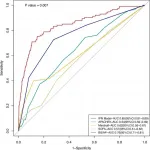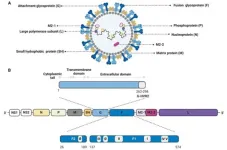First demonstration of quantum teleportation over busy Internet cables
Advance opens door for lightning-fast quantum applications without specialized infrastructure
2024-12-20
(Press-News.org)
Northwestern University engineers are the first to successfully demonstrate quantum teleportation over a fiberoptic cable already carrying Internet traffic.
The discovery introduces the new possibility of combining quantum communication with existing Internet cables — greatly simplifying the infrastructure required for distributed quantum sensing or computing applications.
The study will be published on Friday (Dec. 20) in the journal Optica.
“This is incredibly exciting because nobody thought it was possible,” said Northwestern’s Prem Kumar, who led the study. “Our work shows a path towards next-generation quantum and classical networks sharing a unified fiberoptic infrastructure. Basically, it opens the door to pushing quantum communications to the next level.”
An expert in quantum communication, Kumar is a professor of electrical and computer engineering at Northwestern’s McCormick School of Engineering, where he directs the Center for Photonic Communication and Computing.
Only limited by the speed of light, quantum teleportation could make communications nearly instantaneous. The process works by harnessing quantum entanglement, a technique in which two particles are linked, regardless of the distance between them. Instead of particles physically traveling to deliver information, entangled particles exchange information over great distances — without physically carrying it.
“In optical communications, all signals are converted to light,” Kumar explained. “While conventional signals for classical communications typically comprise millions of particles of light, quantum information uses single photons.”
Before Kumar’s new study, conventional wisdom suggested that individual photons would drown in cables filled with the millions of light particles carrying classical communications. It would be like a flimsy bicycle trying to navigate through a crowded tunnel of speeding heavy-duty trucks.
Kumar and his team, however, found a way to help the delicate photons steer clear of the busy traffic. After conducting in-depth studies of how light scatters within fiberoptic cables, the researchers found a less crowded wavelength of light to place their photons. Then, they added special filters to reduce noise from regular Internet traffic.
“We carefully studied how light is scattered and placed our photons at a judicial point where that scattering mechanism is minimized,” Kumar said. “We found we could perform quantum communication without interference from the classical channels that are simultaneously present.”
To test the new method, Kumar and his team set up a 30 kilometer-long fiberoptic cable with a photon at either end. Then, they simultaneously sent quantum information and regular Internet traffic through it. Finally, they measured the quality of the quantum information at the receiving end while executing the teleportation protocol by making quantum measurements at the mid-point. The researchers found the quantum information was successfully transmitted — even with busy Internet traffic whizzing by.
Next, Kumar plans to extend the experiments over longer distances. He also plans to use two pairs of entangled photons — rather than one pair — to demonstrate entanglement swapping, another important milestone leading to distributed quantum applications. Finally, his team is exploring the possibility of carrying out experiments over real-world inground optical cables rather than on spools in the lab. But, even with more work to do, Kumar is optimistic.
“Quantum teleportation has the ability to provide quantum connectivity securely between geographically distant nodes,” Kumar said. “But many people have long assumed that nobody would build specialized infrastructure to send particles of light. If we choose the wavelengths properly, we won’t have to build new infrastructure. Classical communications and quantum communications can coexist.”
The study, “Quantum teleportation coexisting with classical communications in optical fiber,” was supported by the U.S. Department of Energy (grant number DE-AC02-07CH11359).
END
ELSE PRESS RELEASES FROM THIS DATE:
2024-12-20
About The Study: The findings of this cross-sectional study underscore significant disparities and gaps in biennial mammography screening for women ages 40 to 49. Two-fifths of women in this age group did not receive biennial screening. Lower biennial screening rates were observed among racial and ethnic minority populations, sexual minority populations, rural residents, and socioeconomically disadvantaged populations. To optimize early breast cancer detection, ensuring equitable adherence to U.S. Preventive Services Task Force recommendations is crucial.
Corresponding Author: To ...
2024-12-20
About The Study: This study found that early adoption and implementation of Tobacco 21 (T21) policies (minimum age of 21 for legal access to tobacco products) maximizes potential premature mortality reductions. However, the strength of T21 policies and enforcement varies widely across states. Enforcement of the federal T21 law is critical in the 8 states without state-level T21 cigarette policies of their own.
Corresponding Author: To contact the corresponding author, Jamie Tam, PhD, email jamie.tam@yale.edu.
To access the embargoed study: Visit our For The Media website at this link ...
2024-12-20
Artificial intelligence can provide critical insights into how complex mixtures of chemicals in rivers affect aquatic life – paving the way for better environmental protection.
A new approach, developed by researchers at the University of Birmingham, demonstrates how advanced artificial intelligence (AI) methods can help identify potentially harmful chemical substances in rivers by monitoring their effects on tiny water fleas (Daphnia).
The team worked with scientists at the Research Centre for Eco-Environmental Sciences (RCEES), in China, and the Hemholtz Centre for Environmental Research (UFZ), in Germany, to analyse ...
2024-12-20
December 20, 2024 — For women undergoing breast reconstruction after mastectomy, older age is associated with small but significant increases in certain complications, reports a study in the January issue of Plastic and Reconstructive Surgery®, the official medical journal of the American Society of Plastic Surgeons (ASPS). The journal is published in the Lippincott portfolio by Wolters Kluwer.
Older women may be less satisfied with the appearance of the reconstructed breasts, ...
2024-12-20
Academics from Northumbria University are part of an international research team which has used data from satellites to track changes in the thickness of the Greenland Ice Sheet.
Global warming is causing the Ice Sheet to melt and flow more rapidly, raising sea levels and disturbing weather patterns across our planet.
Because of this, precise measurements of its changing shape are of critical importance for tracking and adapting to the effects of climate warming.
Scientists have now delivered the first measurements of Greenland Ice Sheet thickness change using CryoSat-2 and ICESat-2 – the ESA and ...
2024-12-20
A new prediction model for infected pancreatic necrosis (IPN) in patients with acute pancreatitis (AP) offers a groundbreaking approach to improving patient outcomes. Developed by a team of researchers across eight Chinese hospitals, the model harnesses five early clinical indicators—respiratory rate, temperature, serum glucose, calcium, and blood urea nitrogen (BUN)—to identify high-risk patients within 24 hours of hospital admission.
The study, recently published in eGastroenterology, analyzed data from over 3,000 patients diagnosed with AP between 2017 and 2023. Researchers employed advanced statistical methods, including LASSO regression and multivariate analysis, to develop ...
2024-12-20
Using an AI tool, researchers at Karolinska Institutet have analysed brain images from 70-year-olds and estimated their brains’ biological age. They found that factors detrimental to vascular health, such as inflammation and high glucose levels, are associated with an older-looking brain, while healthy lifestyles were linked to brains with a younger appearance. The results are presented in Alzheimer's & Dementia: The Journal of the Alzheimer's Association.
Every year, over 20,000 people in Sweden develop some form of dementia, with Alzheimer’s disease accounting for approximately two-thirds of cases. However, the speed at which ...
2024-12-20
Respiratory syncytial virus (RSV) is a major cause of respiratory infections, particularly in infants, children under 5 years, and older adults. Its rapid spread makes RSV a serious public health concern. Currently, there are no effective medications for RSV, and current treatment focuses on providing supportive care and preventing its spread.
In a recent study, authors from the Chinese Academy of Medical Science and Peking Union Medical College, Nanjing Medical University, Children's Hospital of Chongqing Medical University, National Institute for Viral Disease Control and Prevention of the Chinese Center ...
2024-12-20
Scientists have discovered a way to remove toxic compounds from potatoes, making them safer to eat and easier to store. The breakthrough could cut food waste and enhance crop farming in space and other extreme environments.
Potato plants naturally produce chemicals that protect them from insects. The chemicals, called steroidal glycoalkaloids, or SGAs, are found in high quantities in the green parts of potato peels, and in the sprouting areas. They render the potatoes unsafe for insects as well as humans.
"These compounds are critical for plants to ward off insects, but they ...
2024-12-20
The war in Ukraine is causing hunger thousands of miles from the battlefields, according to a study released today.
Nearly three years of war in the “breadbasket of the world” has left croplands destroyed and forced laborers who grow, harvest and process a bounty of wheat, barley and oats to flee. Combined with export bans from other countries, ripple effects resonated through global trade and upended food supply systems.
But understanding how far those disruptions reached, who suffered and who gained has been difficult. Researchers at Michigan State University’s Center for Systems Integration and Sustainability (CSIS) lead a unique effort, relying ...
LAST 30 PRESS RELEASES:
[Press-News.org] First demonstration of quantum teleportation over busy Internet cables
Advance opens door for lightning-fast quantum applications without specialized infrastructure



